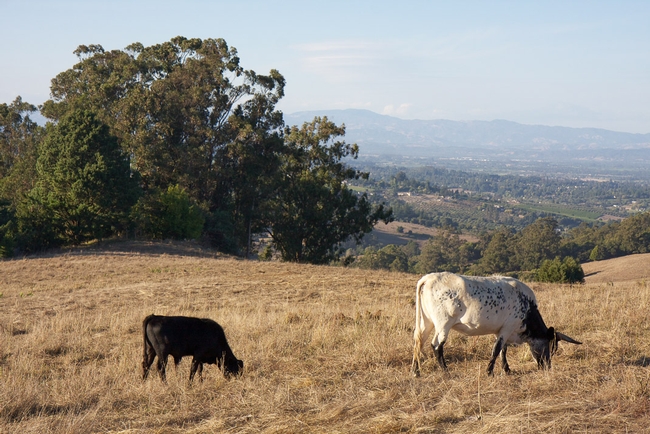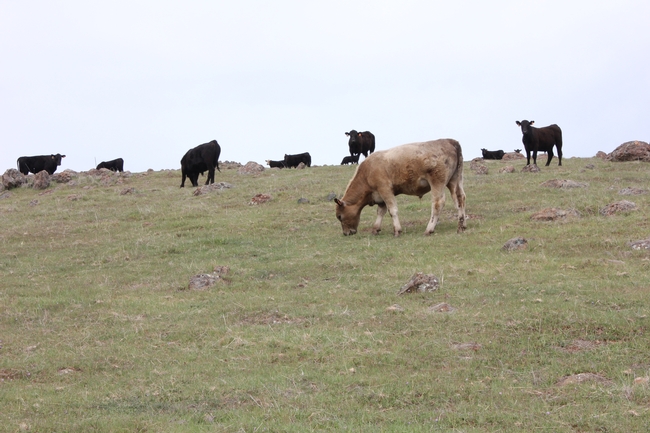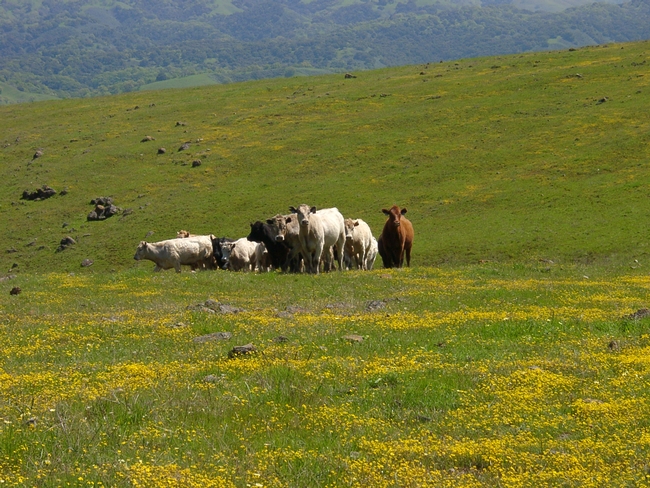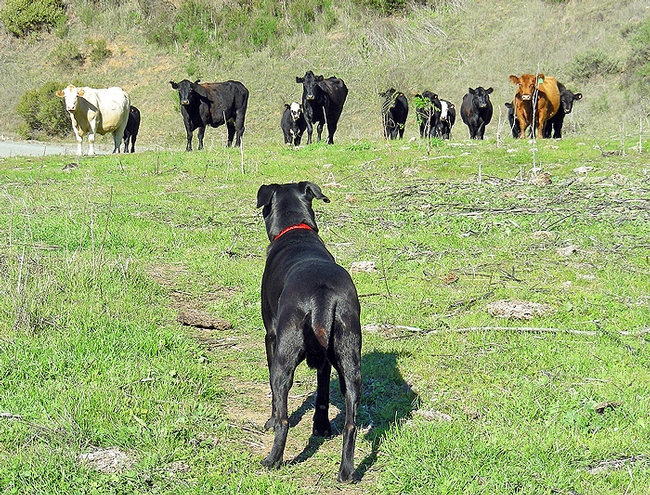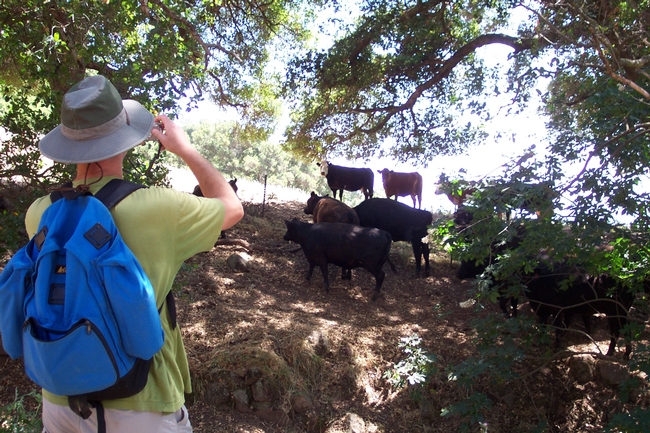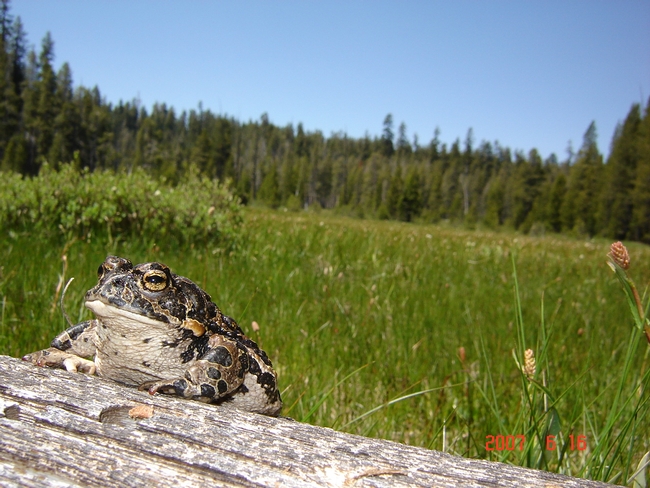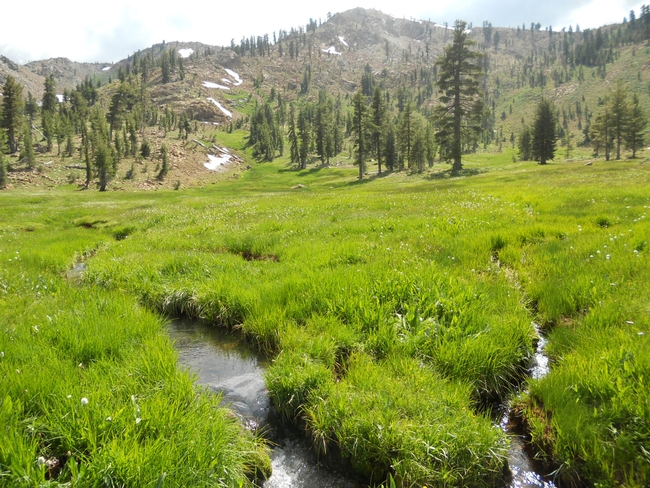Posts Tagged: grazing
UCCE advisors promote targeted grazing to reduce wildfire threat
The natural magic of grazing at the Table Mountain Ecological Reserve in Butte County is made possible by running cattle in targeted areas for carefully planned periods of time, reported Ashiah Scharaga in the Chico News & Review.
"If we reduce the amount of vegetation that is there through livestock grazing, we can reduce the amount of fuels that would be available to help a fire spread and carry and build up intensity," said Tracy Schohr, UC Cooperative Extension livestock and natural resources advisor in Butte, Plumas and Sierra counties.
Targeted grazing, Schohr said, also keeps down grasses, weeds and invasive species, serving as an element in the land management "toolbox."
"If cattle were not actually on Table Mountain Ecological Reserve, essentially those invasive species would choke out those native plants, and they wouldn't be there," Schohr said.
In the past, grazing was considered destructive, however, perspectives have changed with fire science research. One such researcher is Kate Wilkin, the fire science and natural resources advisor for UCCE in Butte, Yuba, Sutter and Nevada counties.
Wilkin said that there has been a long history of grazing in the West, dating to the 1700s. Livestock historically overwhelmed the environment, causing degradation to wetlands and meadows especially. Using animals in a targeted way, however, can reduce fire risk without destroying the natural landscape.
Schohr and Wilkin will host a day-long Irrigated Pasture and Annual Rangeland Management Workshop May 31 at the Chico State University Farm.
Low residual dry matter on rangeland a concern heading into wet season
With some recent forecasts bringing encouraging news about a potential El Niño, some ranchers have been asking about what they should expect in terms of forage production, if and when the rains come. What they want to know is how soon rangeland productivity will reach the pre-drought levels again. One issue that I always draw their attention to is the levels of residual dry matter (RDM) on the rangelands. Even with the reduction in herd sizes and shorter grazing seasons employed by most producers, more rangelands now have less than recommended RDM levels.
RDM is a measure of the old plant material (without counting summer annuals) that are left standing or on the ground before the fall precipitation comes. It is a great indicator of both forage production and grazing intensity. These leftover plant materials are critical on California rangelands to reduce erosion and nutrient loss, and to create a conducive environment for diverse plant communities to thrive. Optimum RDM levels are site specific, they range from 100-2,100 pounds per acre, and depend on precipitation zone, slope and tree canopy cover. Ideal RDM levels increases with precipitation and slope, and decreases with tree cover. Studies show that too low or too high RDM levels will reduce species composition and forage production, both factors critical to any livestock production system. The good news is that annual rangelands are resilient and will likely return to normal production within two years after bringing RDM level to recommended standards.
Knowing the RDM standards for one's rangeland and continuously monitoring is an important step towards achieving sustainable rangeland management and livestock production.
Details about RDM standards, data collection methods and more can be found in the free UC Agriculture and Natural Resources publication Guidelines for Residual Dry Matter on Coastal and Foothill Rangelands in California.
Author: Fadzayi Mashiri, Ph.D.
Grazing is good for public lands
The author, Sheila Barry, the natural resources and livestock advisor for UC ANR Cooperative Extension in the Bay Area, wrote that overgrazing and impacts to riparian woodlands are legitimate concerns, but have been effectively addressed with modern range management practices. Ranchers can minimize harmful impacts by maintaining proper stocking rates, creating riparian pastures, limiting grazing in sensitive areas and adding off-stream water sources.
Barry delineated a series of beneficial impacts of cattle grazing on Bay Area parklands. She said grazing minimizes wildfire hazards, manages non-native annuals, prevents thatch build up, promotes flowering plants, and improves carbon sequestration.
Barry added that no documented plant or animal species extinction has been linked to cattle grazing in California. On the contrary, numerous threatened and endangered species rely on grazing and rancher stewardship, including Santa Cruz tar plant, Contra Costa goldfields, Sonoma spineflower, San Joaquin kit fox, California tiger salamander, California red-legged frog, Ohlone tiger beetle, and Bay checkerspot and Callippee silverspot butterflies.
The magazine also included a "con" argument, written by Karen Klitz, a member of the Western Watersheds Project board of directors, and Jeff Miller, a conservation advocate with the Center for Biological Diversity and director of the Alameda Creek Alliance. The authors say grazing is incompatible with conservation because damage wrought by livestock is not a thing of the past. Klitz and Miller cite research showing that removing cattle can restore trout populations, native songbirds, wildflowers and amphibians. Grazing cessation at Mount Diablo State Park decreased weedy species and increased native grassland species and supports 16 rare or endangered wildlife species, the article said.
Does social media reveal how we feel about cattle grazing?
To get a more complete picture of public perceptions of cattle grazing, Sheila Barry, University of California Cooperative Extension advisor in the San Francisco Bay Area, analyzed photos and comments in the photo-sharing website Flickr.
Her study, published in the February 2014 issue of Environmental Management, showed that Flickr can provide insight both through photos and comments into public perspectives on grazing in parks and open space lands.
“These are just a first step toward broadening this understanding,” Barry wrote. “Further analysis of social media may provide managers with broader insights into public opinion compared to those afforded by traditional methods on a wide range of issues important to park and open space management.” Livestock grazing reduces the volume of plants that can fuel fire and improves wildlife habitat. But some public land managers, concerned about potential conflicts with park users, limit or ban grazing. In 2009, the city of Walnut Creek decided to end grazing in two city parks. A year later, neighbors who were concerned about weeds contributing to wildfire petitioned the city to resume cattle grazing.
Assessments of public perceptions are often based on public hearings, which tend to attract special interests and favor negative input, or on surveys, which focus on a topic.
“Despite numerous studies that have shown benefits of grazing for endangered species in California, some environmental groups and park users have filed lawsuits to curtail grazing on public rangelands,” Barry said. “I think there's an opportunity to educate people that if grazing is well managed, it won't interfere with their recreational use and there are benefits to society.”
The San Francisco Bay Area has over 133,000 acres of public land that is grazed by cattle and used by people to hike, ride bikes, walk dogs, ride horses and hang glide.
Barry set out to explore how people voluntarily described their feelings about cattle grazing in the San Francisco Bay Area on social media. She examined photos and comments on Flickr. Using the search terms “cow,” “cows” and “grazing,” she found 1,087 photos of grazed regional parks in Alameda, Contra Costa or Santa Clara counties by 328 people with 956 comments.
Of the 733 photos that were accompanied by comments, 71 percent showed a cow and 71 percent of the comments were descriptive without expressing opinion about cows or grazing. Comments included “Lots of wildflowers and cows. Hello tiny cows on the hillside.” “Taken at Lake Del Valle.” “I don't know why, but I thought cows in California were kept indoors.” About 23 percent were positive toward cows and grazing, such as “Wonderful to see cows being just cows and happy ones” and “As much as I struggled over the steep hills on this hike, all the grazing cattle and howling coyotes made it worth the sweat.”
Fear of cows was expressed by 5 percent of commenters and included comments such as “I try to conquer my fear of cows by photographing them,” “The cows scared us to death. I told them that I'm a vegetarian and they let me go” and “We turned around when we were faced with the option of having to walk right through a herd of cows.”
Less than 1 percent described cows behaving aggressively, such as “At least these cows didn't chase us like last week's did.”
Although more research is needed to learn how to collect, analyze and interpret data from social media, Barry believes it could be a valuable source for informing decisions about public policy.
Insight into public perceptions of cattle grazing will enable park managers to craft more effective education and interpretation messages about park use and management.
“We are currently using insight from this project to develop education and interpretative information and panels for parks in the East Bay,” Barry said.
Barry is publishing fact sheets for park managers and interpreters to share with park visitors. The fact sheets will address concerns she saw raised in the Flickr study such as how to safely and comfortably recreate in a park near grazing cattle and the benefits of cattle grazing in parks. She will also address public interest and questions revealed in the Flickr study with facts sheets titled “A Year in the Life” and “Bovines, Ovines, Caprines and Equines: What's the difference?” The fact sheets will also be available online and similar information will be posted in parks on interpretative panels.
The article “Using Social Media to Discover Public Values, Interests, and Perceptions about Cattle Grazing on Park Lands” can be downloaded at http://link.springer.com/article/10.1007%2Fs00267-013-0216-4.
Yosemite toad undeterred by cows grazing in meadows
Amphibians are in decline globally. The Yosemite toad was once prevalent in the high Sierra including Yosemite National Park, where it was first discovered and after which it is named. Since the early 1980s, the amphibian’s population and habitat have plummeted.
In the Sierra Nevada Mountains, where livestock graze among toad habitat, UC scientists erected fences to keep the cattle out of toad breeding and rearing areas and studied the effects on Yosemite toad populations for five years.
“The Yosemite toad has been proposed for listing under the Endangered Species Act,” said Ken Tate, UC Cooperative Extension specialist in the Department of Plant Sciences at UC Davis and a principal investigator for the study. “One of the potential factors proposed to be driving the species decline is cattle grazing. However, our research does not support this.”
The researchers found that meadow wetness played a greater role in Yosemite toad presence.
"The toads use wetter areas and the cattle use drier meadow areas, which provide better forage,” Tate said.
“Determining the Effects of Cattle Grazing Treatments on Yosemite Toads (Anaxyrus [=Bufo] canorus) in Montane Meadows” was published in the November 2013 issue of PLOS One http://www.plosone.org/article/info%3Adoi%2F10.1371%2Fjournal.pone.0079263. Tate’s coauthors on the study are Susan K. McIlroy, research scientist with U.S. Geological Survey in Boise, Idaho; Amy J. Lind, research wildlife biologist with the U.S. Forest Service Pacific Southwest Research Station; Barbara H. Allen-Diaz, professor in the Department of Environmental Science, Policy and Management at UC Berkeley; Leslie M. Roche, postdoctoral researcher in the Department of Plant Sciences at UC Davis; William E. Frost, UC Cooperative Extension advisor; and Rob L. Grasso, fishery and aquatic ecologist with U.S. Forest Service Eldorado National Forest.
This is the latest of three articles examining the relationship between cattle grazing and growth in numbers of Yosemite toads. In April 2012, PLOS One published “Cattle Grazing and Conservation of a Meadow-Dependent Amphibian Species in the Sierra Nevada,” online at http://www.plosone.org/article/info%3Adoi/10.1371/journal.pone.0035734. The first article “Cattle Grazing, Mountain Meadows, and Sensitive Species,” written in 2011, is online at http://rangelandwatersheds.ucdavis.edu/main/projects.htm.


